Brian Meert's Blog, page 135
December 13, 2017
How to Give Access to Your Twitter Ads Account
 December 14, 2017
December 14, 2017Anne Felicitas
How to give access to your #twitterads account. #digitaladvertising #digitalmarketing
Click To Tweet

Much like Facebook advertising, it is often difficult to manage Twitter ads without the help of a partner or agency. However, in order to get help, you need to grant ad account access to your partner.
Twitter allows you to give different levels of ad account access to third parties: account administrator, ad manager, campaign analyst, and organic analyst.
Account Administrator: The account administrator has the highest level of access to the account. With full access, the administrator can grant access to the account, assign and edit account roles, change advertiser campaigns, view performance data, access credit card and billing information, and create promoted-only Tweets, also known as limited delivery. The administrator, however, cannot post organic tweets.
Ad Manager: The ad manager can change campaigns, view performance data, and create promoted-only Tweets. The ad manager cannot create new accounts and post organic tweets.
Campaign Analyst: Although the campaign analyst can access ad accounts, the analyst cannot change campaigns, view performance data, create new accounts, and post organic or promoted-only Tweets.
Organic Analyst: Although the organic analyst can access ad accounts and view analytics, the analyst does not have access to view paid campaigns.
Below are the steps to giving Twitter users access to your Twitter ad account.
Step 1: Click “Edit access to account” on your Twitter ad account
Log in to ads.twitter.com. Click the expand arrow beside your Twitter username.
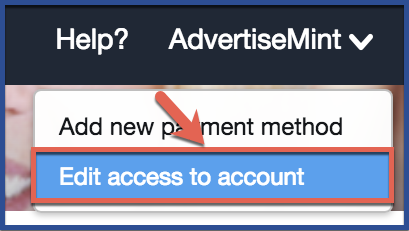
Step 2: Click “Add Access”

Step 3: Type the name of the user and assign a role

Step 4: Click “Save Changes”

Step 5: You’re Done

You can edit the Twitter user’s account role at any time.
The post How to Give Access to Your Twitter Ads Account appeared first on AdvertiseMint.
4 Ways to Test, Measure, and Learn with Facebook During the Holidays
 December 13, 2017
December 13, 2017Anna Hubbel

Facebook has multiple measurement solutions to help you optimize your marketing campaigns during the holiday season, as well as to improve strategies as you go.
Use @Facebook #measurementsolutions to improve marketing strategies for your brand during the holidays.…
Click To Tweet
Below is a list of four ways to use Facebook to test, measure, and learn during the holidays.
1. Split Testing
Split testing gives you the advantage of trying different ads, tactics, or audiences without waiting for one campaign to finish first. Try the same ad with different audiences. Or use a different delivery method. Work with multiple different creative strategies and see which works for one audience type. Facebook takes the results of your tests and delivers them to you within three days so you can make improvements to campaigns as you go.
2. Facebook Pixel
Particularly during the holidays, learning everything you can about your audience’s interests and behaviors is extremely helpful to your campaign. Install the Facebook Pixel on your website to track customers who purchase or show interest in your products. This makes it easier to improve your ads and campaigns and cater to the audiences most likely to buy.
3. Connect the Dots
Online and offline purchases go hand-in-hand these days. To learn how online ads get customers to make in-store purchases, use Facebook resources such as Business Manager, the Offline Conversions API, and partner integrations, which make those connections between your Facebook ads and offline conversions. Identifying those connections allows you to see what is working towards driving offline purchases.
4. Use Measurement Insights
Use any insights you gather from split testing, Facebook Pixel data, or offline purchase tracking to improve your ad sets and better refine your brand. With the New Year just around the corner, insights you collect from your measurement insights will give you a competitive edge in the kick-off of 2018.
Take advantage of the heightened opportunities during the holidays to emerge as an even more successful and efficient business with intellectual Facebook marketing strategies that you’ve refined to perfection based on what you’ve learned.
For more holiday advice, read about these 3 Facebook Marketing Tips for the Holidays.
The post 4 Ways to Test, Measure, and Learn with Facebook During the Holidays appeared first on AdvertiseMint.
December 12, 2017
The Three Facebook Custom Audiences You Need to Use
 December 12, 2017
December 12, 2017Sherrilynne Starkie
If you don't use these @facebook Custom Audiences, you won't garner sales. #digitaladvertising…
Click To Tweet

Sixty-two percent of small business owners say they hardly make any sales on Facebook , according to a recent survey of 2,600 business owners by Weebly. That’s likely because these owners aren’t using Facebook’s Custom Audience, one of the most powerful Facebook tools to use. It is great for targeting current customers, increasing the value of sales, boosting sales conversion rates, building brand awareness, and more.
While Facebook Core Audiences uses demographic information such as age, location, languages, interests, behaviors, and connections, Custom Audience uses a company’s own customer data for precision targeting. There are three types of Custom Audiences.
1. Basic Custom Audience
A basic Custom Audience uses a company’s own list of customers and prospects such as CRM and POS data or mailing lists. Facebook uses specific details such as email addresses, phone numbers, names, zip codes, locations, and user IDs to target these individuals via Facebook ads, Instagram ads, or Audience Network. Basic Custom Audience is highly efficient in targeting ads and in supplementing direct marketing campaigns.
The basic Custom Audience proved effective in raising brand awareness and driving online purchases for Wander Beauty, a cosmetic company start-up. As part of a campaign, Wander Beauty’s marketing team created a Custom Audience of existing customers and segmented it by interests such as products, cosmetics, and online buyers. The team then targeted the audience with a series of how-to and product video ads. In just two months, the total campaign quadrupled sales, cut cost per sale by more than half, and more than doubled conversion rates.
2. Website or Mobile App Custom Audience
The Website Custom Audience uses the Facebook Pixel, a tiny bit of code installed on a website, to recognize and track Facebook users who travel from web page to web page. The pixel activates when visitors land on a specific page or take a certain action. The visitors can then can be targeted with specific ads, depending on where they are in the sales funnel. The same principles apply for the Mobile App Custom Audience. Using SDK, Facebook’s software development kit, advertisers can track an app user’s journey to drive in-app sales.
BottleKeeper, a company that manufactures beer bottle containers, used the Website Custom Audience to generate sales. As part of its campaign, BottleKeeper used the Facebook Pixel to reach people who had abandoned an online purchase. The campaign retargeted users with special offer ads, each with a direct link to the website’s shop section. The one-week campaign attracted hundreds of new customers and garnered more than $25,000 in sales.
3. Engagement Custom Audience
The Engagement Custom Audience uses the behaviour of Facebook users as targeting criteria. When users visit a Facebook page, watch a video, click on a lead ad, or open a mobile ad, they may be targeted in an Engagement Custom Audience.
Popeyes Louisiana Kitchen used Engagement Custom Audience as part of a campaign to boost brand awareness. A key component of the program was a Facebook Mobile Canvas ad which highlighted the restaurant’s chicken marinating process. It retargeted people who had interacted with past Popeyes videos to re-engage them. The campaign reached five million people and increased ad recall by 9.3 percent.
Small business owners wishing to improve the returns on their Facebook advertising investment should use Custom Audiences, Facebook’s easy-to-implement, highly measurable, and effective targeting tools.
Sherrilynne Starkie is an award-winning digital communications consultant with more than 20 years in agency experience. She helps organizations deal with big challenges, sits on IABC Canada Eastern Regional Board, and volunteers with the Ottawa Senators Foundation. You can connect with her on Facebook, Twitter and LinkedIn.
The post The Three Facebook Custom Audiences You Need to Use appeared first on AdvertiseMint.
December 11, 2017
New Snapchat Algorithm Prioritizes Most Relevant Content
 December 12, 2017
December 12, 2017Anna Hubbel
 Photo Courtesy of TechCrunch
Photo Courtesy of TechCrunchIf you’re a loyal Snapchat user, you definitely noticed the app’s new way of organizing your content. Snapchat now sorts content based on its importance and relevance to each user, prioritizing Snaps and Discover content that your past activity indicates are most valuable to you.
@Snapchat 's new #algorithm prioritizes the most relevant content for each user. #socialexperience
Click To Tweet
Instead of organizing content in chronological order or placing what is considered popular by the masses first, Snapchat is now giving you a more personalized experience.
If you’re an advertiser, this is particularly promising news, especially if users viewed your ads or content in the past, because the new algorithm increases the likelihood that your content will appear higher in users’ feeds. Additionally, users will be less inclined to skip content and be more inclined to view your ads in full if most of what they see feels personalized.
What’s Different
Main Screen and Navigation
Now when you open the Snapchat app, in addition to the typical open-to-camera feature, you get a navigation screen in the form of a profile. There, you’ll see the views of your recent Story, of Snapchat’s Our Story, and of your other group Stories. There, you can also easily access Snap Map.
 From the profile, users can download their Stories, add friends, and access settings. Photo courtesy of Tech Crunch.
From the profile, users can download their Stories, add friends, and access settings. Photo courtesy of Tech Crunch.Most Relevant First
According to TechCrunch, your new Snaps and chats are located at the top of the Friends tab. Closest friends’ Snaps come next, which are then followed by Snaps from other, less-interacted-with users.
As for major Snapchat influencers, TechCrunch says their Snaps (if you follow them) now appear in Discover. Influencers’ Snaps will only appear in your Friends tab if they follow you back.
 Snapchat’s Friends tab contains messages and Snaps from friends. Photo courtesy of TechCrunch.
Snapchat’s Friends tab contains messages and Snaps from friends. Photo courtesy of TechCrunch.Preview Feature
Snapchat also added a new preview feature for Snaps. Instead of one Snap playing after another or you manually choosing which Stories to view, a brief preview screen in between Stories show which friend’s Story comes next. You can use this preview feature to either swipe down to exit or swipe to the next preview.
A New Discover Experience
TechCrunch says the new Discover layout displays large preview tiles of publishers and creators you’ve subscribed to at the top of your feed. Below that content, you see content generated by Snapchat based on information the app has gathered from your past activity. If you see content you don’t really care about, you can select the option to see less of that type of content.
If you’re a social media star, you are in luck: Snapchat will now promote popular, content-approved stars to new audiences. In other words, users may see content from a social media star they do not currently follow under Popular Story. This is a good incentive for anyone who wants to monetize as a social media influencer, as there is greater promise for growth.
With this new algorithm, Snapchat is now competing against its rival, Instagram and its identical algorithm.
The post New Snapchat Algorithm Prioritizes Most Relevant Content appeared first on AdvertiseMint.
December 10, 2017
21 Instagram Influencers and What You Can Learn from Them
 December 9, 2017
December 9, 2017Kaitlin Westbrook
21 #instagraminfluencers & what you can learn from their journey. #socialmedia
Click To Tweet

Before the Internet, influence was fairly cut and dry. Film and television stars, politicians, and upper crusters were all people we might have considered influential. A stay-at-home parent, on the other hand, was simply a normal (albeit vital) member of society. How could a parent’s story possibly influence others? Who would care about a cosmetics-obsessed teen, a crafty twenty-something, or a traveling hippie? Forget about it.
The Internet has changed our definition of influential, and ultimately, our culture. Long gone are the days when people imagined what it must be like to be a celebrity because Instagram influencers are celebrities to many people. What’s more, they often interact with their followers, sharing their own relatable situations and struggles.
Why Are Influencers Popular?
Instagram celebrities often garner popularity because of their down-to-earth stories, rather than their stories of opulence or scandal. Whatever your niche is, in whichever subculture you belong, there is most likely someone who has made a related blogging business for you.
Although this may set unrealistic expectations for you, Instagram has become a place where everyday people can truly build careers by documenting their stories. So, what can you take away from these influencers when sharing what you have to say? Today, we’ll discuss 21 Instagram influencers and the lessons you can learn from them.
1. @hudabeauty
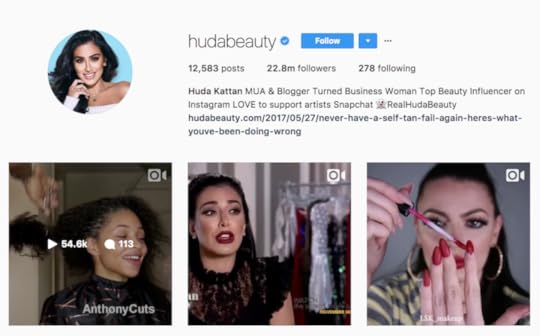
Who:
Huda Kattan is a beauty blogger and makeup artist with a whopping 22.8 million followers. Kattan covers products, beauty tips, natural skin and hair recipes, and more. She even has her own line of cosmetics and beauty products available worldwide.
What you can learn:
In some ways, Kattan’s success seems unattainable. However, it was her lifelong obsession with cosmetics that led her to make her first video, a video that would be the first of many.
Now, only a few years later, she is recognized as one of the top beauty influencers in the world. Even with her finance degree, Kattan pursued her interests on the side—it was the pursuit of that passion that earned Kattan her success.
If you have a lifelong obsession like Kattan, use it to pursue your business.
2. @babyboybakery
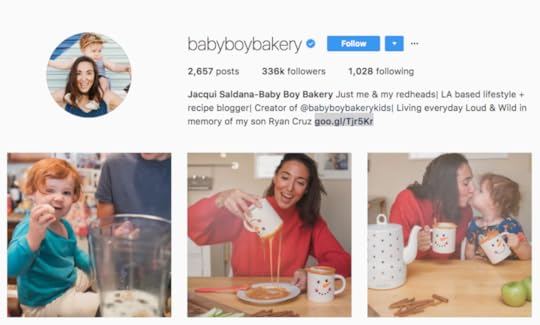
Who:
Jacqui Saldana is the founder of Baby Boy Bakery, a blog about baking, life, grief, and family. Saldana initially began blogging when her son was an infant and continued after he passed away. She continues to share recipe tips, personal stories, and, recently, posts about her daughter.
What you can learn:
Despite tragic circumstances, Saldana managed to build a business on her blog’s initial purpose: family and cooking. Through her work, she supported several charities and became an advocate for worthy causes.
If you’re are passionate about a cause or if a cause has affected you, think of the ways you can incorporate those causes into your brand and, consequently, touch others’ lives.
3. @brightbazaar
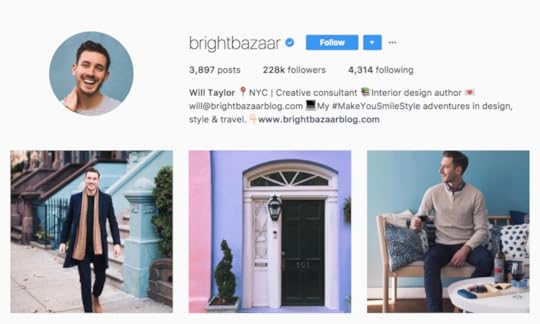
Who:
Will Taylor is an interior design author and creativity expert. He specializes in capturing beautiful spaces and places, wherever he goes.
What you can learn:
When you visit Taylor’s Instagram, you’ll notice his photos don’t show the landscapes of Bali or the streets of Rome. In fact, many of his pictures feature unmade beds or comfortable living rooms. Taylor’s photos are beautiful, however, because he photographs subjects in an artful way—the way he sees them.
If, like Taylor, you see ordinary things as beautiful, think of ways to capture them in a unique and creative way.
4. @asiyami_gold
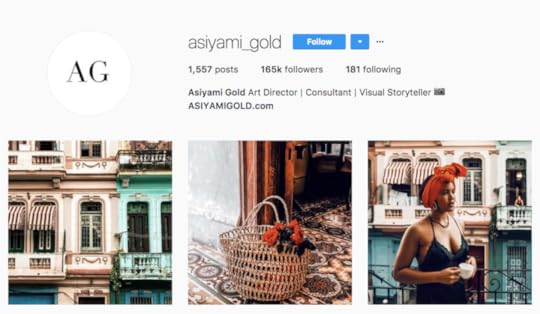
Who:
Asiyami Gold is an art director with a beautiful, earthy style. Her Instagram is a travel diary packed with culture and texture. As a visual storyteller, Gold finds beauty in everything and shares it with her followers.
What you can learn:
Gold is someone who has made living part of her business, creating a highly specific aesthetic with her Instagram. By using travel as a platform for her brand, Gold is able to experience the places that are meaningful to her.
If there are places that are meaningful to you, incorporate them into your social media.
5. @itsdougthepug
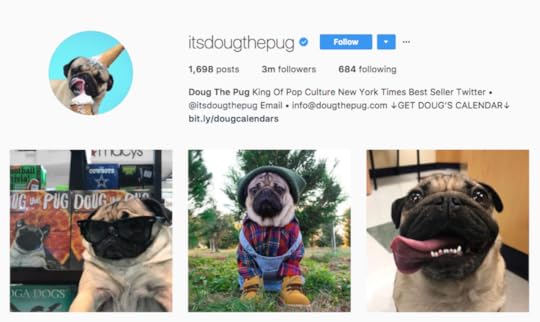
Who:
Doug the Pug is the world’s most beloved pug. This tiny guy is potentially the best dressed dog out there, garnering fame and 3 million followers for his classically droopy face and adorably ironic outfits.
What you can learn:
People adore dogs. In an age where tragedy is a Twitter scroll away, pets offer a nice reprieve from daily life. Doug’s young owner, Leslie Mosier, worked hard to make Doug famous, building a brand from scratch and updating Doug’s blog consistently.
If you have a pet or an animal you adore, use it as a mascot for your brand and a mood booster for your audiences.
6. @thepacman82
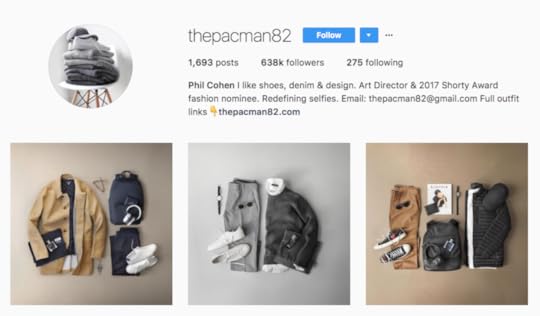
Who:
Phil Cohen is an art director turned Instagram fashion influencer. He photographs outfits and accessories to over 600,000 followers daily in a consistent and beautiful way.
What you can learn:
Although Cohen wanted to photograph his daily outfits, selfies weren’t his thing. With a personalized flat-lay photography style, Cohen has become a major player in menswear blogging. By perfecting a style and sharing it with others, Cohen’s Instagram has become iconic.
If selfies aren’t your thing, think of creative ways to capture your products. You can lay them on a flat surface like Cohen or you can fit them on your brand’s live animal mascot.
7. @sanias
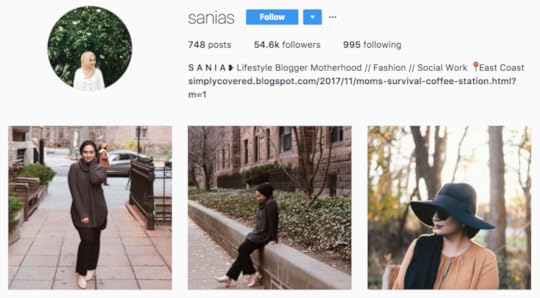
Who:
Sania is a Muslim-American lifestyle blogger and social worker. Her Instagram is a compilation of motherhood, personal events, and fashion statements.
What you can learn:
Although the life of a social worker and mom isn’t typically glamorous, Sania managed to construct a social media profile that is both gorgeous and down to earth. Sania blogs about daily life, and her blog constantly finds beauty in simple things.
Think of ways to add a little glamor to your social media presence, whether you’re captured drinking coffee at starbucks, working in front of a computer, or taking a stroll through the city.
8. @studiodiy
Who:
Kelly Mindell is a creative lifestyle and DIY blogger. Her brand is all about fun, color, and the projects that can incorporate both. Her blog and Instagram share craft ideas, holiday projects, and more.
What you can learn:
Mindell is the definition of hustle, or as she calls it, working the system. She has worked hard since middle school to teach herself art, design, and fashion, even during the time she was recuperating from cancer. Eventually, she created a brand that was unique to her and pursued it with everything she had.
Think about your unique style. Then work the system to create that style.
9. @joelsartore

Who:
Joel Sartore is a National Geographic photographer who uses Instagram as a platform to educate his followers about various animals and wildlife. If you’re an animal lover, this is the Instagram for you.
What you can learn:
Sartore not only shares photographs, but he also uses his influence for altruistic reasons, seeking to educate others about endangered species. By showing the beauty of wildlife to his followers, Sartore is encouraging his audience to care and take action.
Do you have charities you care about? If so, use your brand to educate others about that charity.
10. @thefeedfeed

Who:
Julie Resnick runs The Feedfeed, a community where bakers, chefs, and everyone in-between can share and benefit from colorful recipes and foodie photos. This community especially benefits those who seek to eat local, something very important to The Feedfeed team.
What you can learn:
The founders of The Feedfeed noticed there wasn’t yet a platform for cooks who made and ate local, seasonal food. Seeing an opportunity to help people like themselves, they created TheFeedfeed, a crowdsourced company made for people who love food as much as they do.
If you wanted something that doesn’t exist, create it.
11. @whitneyleighmorris
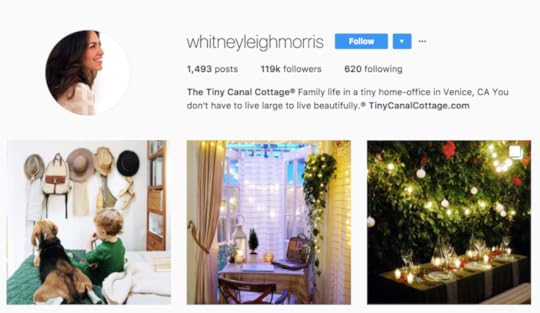
Who:
Whitney Leigh Morris is a creative director who is redefining the dream home. Her house in Venice, CA, which she lovingly refers to as the The Tiny Canal Cottage, functions as a home, office, studio, and now, a business—oh, and it’s under 400 square feet.
What you can learn:
Morris has made a business of living efficiently. Her blog documents what it’s like to live, work, and raise a family in a tiny house. She shares tips that allowed her to organize and live small.
Think about how you can redefine ideas about home and family in your own brand.
12. @theonigiriart
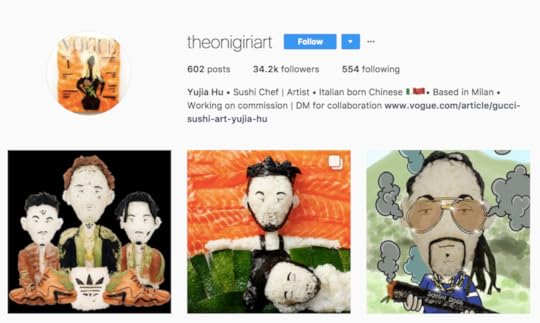
Who:
Yuija Hu is a Milan-based sushi artist. After taking a hiatus from art school to work in his family’s sushi restaurant, Hu began making sushi art based on the people and imagery prevalent in pop culture.
What you can learn:
Although his studies were interrupted, Hu continued his creative pursuits by pairing food and art. Despite a sudden change in circumstances, Hu cultivated a following of his most recent art style.
Think of ways you can creatively work an unexpected situation to your advantage.
13. @emilywrecker
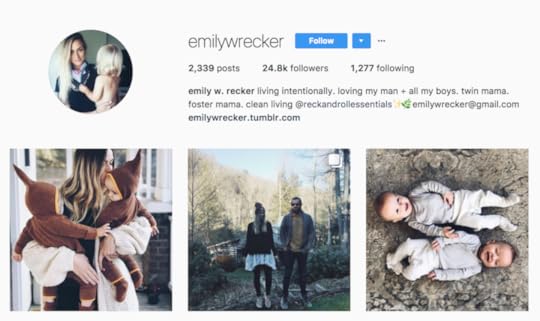
Who:
Emily W. Recker runs a mom and lifestyle blog about her twins, as well as what it’s like to be a foster mom. Her Instagram focuses on family, spirituality, and all the small details of her life.
What you can learn:
Wrecker’s Instagram is a simple story about taking life and loved ones a day at a time. She provides a relatable blog people can read and enjoy.
Think of aspects of your life that help you relate to others. Then use those same aspects to connect with your audience.
14. @masgrimes
Who:
David Grimes is a calligraphy artist based in Portland. His blog is a place for both calligraphers and lovers of lettering. He offers resources, tips, and commission opportunities for his readers and fans.
What you can learn:
Although calligraphy may seem like something reserved for history books or luxury purchases, Grimes brings classic art to social media and makes it tangible for his audience.
Use your skillsets and educate others about them on social media.
15. @atomicmari
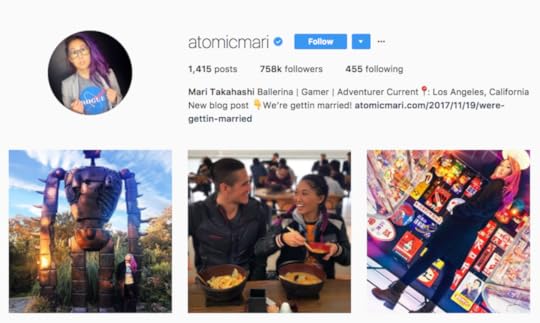
Who:
Mari Takahashi is a content creator and gamer extraordinaire. Her YouTube Channel, Smosh Games, is a widely popular channel with content for numerous video game lovers. Her Instagram documents her travels, life, and nerdy adventures.
What you can learn:
Takahashi is a strong female voice in a male-dominated industry. Her brand is uniquely her, catered to her interests.
Think of ways your niche interests can supplement your band.
16. @highenergyparenting
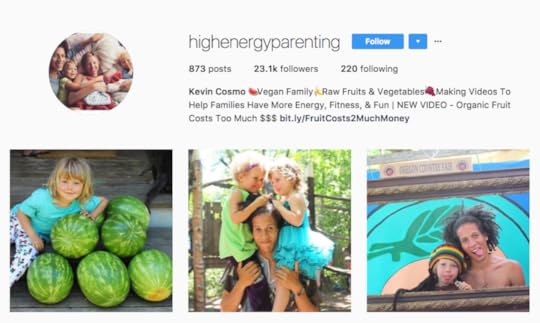
Who:
Kevin Cosmo is a full-time family man and vegan, with an Instagram that illustrates what it’s like to be a health-advocate dad. If you love raw eating and family blogs, this blog is a lighthearted combination of both.
What you can learn:
Cosmo has an Instagram and YouTube channel focused on raising a vegan family. His videos answer questions about the family’s diet and lifestyle choices as they grow.
Think of ways your brand can appeal to families with specific interests and lifestyles.
17. @toyinojihodutola
Who:
Toyin Oijh Odutola is a Nigerian-born, New York-based artist and traveler. Her Instagram doubles as a “studio diary” where she records art and various places worldwide.
What you can learn:
Oijh Odutola’s Instagram is strikingly different from many others on this list. Although the images are carefully curated, there is a rawness in the photos and art she features. Oijh Odutola’s studio diary proves that although Instagram is often a marketing platform, there is certainly a place for candid images and thoughtful art.
Think of ways you can craft your studio diary. Then think of how you could use it as part of your social identity.
18. @graceandsalt
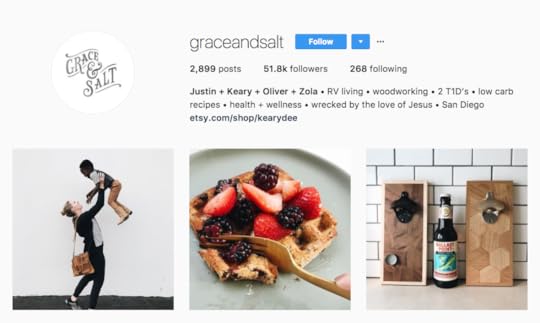
Who:
Justin and Keary are parents and founders of Grace & Salt, a lifestyle blog about family, spirituality, adoption, food, and living in an RV.
What you can learn:
Keary uses her platform to educate people about living with diabetes (something she and her daughter both have), eating healthy, and living RV style. Keary’s Instagram proves these topics are ones people want to read and learn about.
If you are passionate about something that directly affects you, such as health or beliefs, build a brand around it.
19. @jamescharles
Who:
James Charles is not your average beauty blogger. Not yet in his twenties, Charles already garnered 2.7 million followers and earned the position of CoverGirl’s first male ambassador.
What you can learn:
Charles uses his platform to redefine societal expectations. He encourages others to embrace their identities as he does. Charles proves that embracing differences can pay off—literally.
Think of how your identity differs from societal expectations. Then think of a way to develop your differences.
20. @michaelxufuhuang
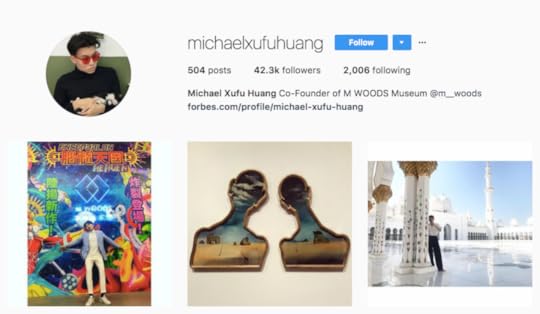
Who:
Michael Xufu Huang is an art collector and museum founder. His Instagram is a rabbit hole of art and personality. For artists and curators, Huang’s blog offers an inside look at the ever evolving art scene.
What you can learn:
Although you may not be an art collector or the founder of a museum, people are interested in experiencing art, both in person and through a screen.
If creativity can be a bold move for your business, think of ways you can bring an artistic flair into your brand.
21. @adventurouskate
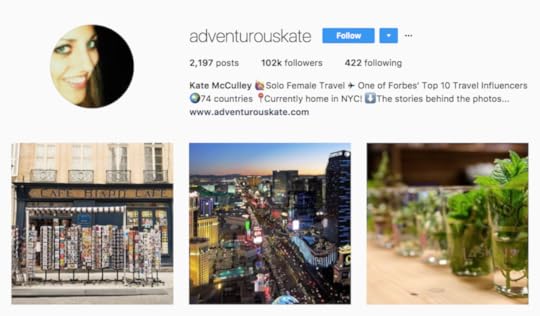
Who:
Kate McCulley is just a girl in the world, one who made traveling a full-time business. Her Instagram documents her travels and adventures from dozens of different countries and cities.
What you can learn:
McCulley isn’t just one of the top travel influencers on Instagram, but she also uses her blog to answer questions and educate others. She discusses various destinations, her unbelievable journey, and the steps to becoming a travel blogger.
Use your social media and blog to answer questions that people ask about your brand.
Whether you’re trying to run a large company, grow a small business, or create your first online presence, Instagram has numerous influencers you can look to for inspiration.
These people prove interests vary greatly—there’s not just one type of successful blogger. Consider who influences you and consider how you can be influential to others. Then get out there and try it for yourself. What have you got to lose?
Kaitlin Westbrook is a content writer for Vecteezy. Kaitlin covers business, creative content, professional writing, and more. When she’s not writing, she enjoys movies, baking, and her Pomeranian. You can connect with her on LinkedIn.
The post 21 Instagram Influencers and What You Can Learn from Them appeared first on AdvertiseMint.
December 9, 2017
How to Install Facebook Customer Chat to Your Website
 December 9, 2017
December 9, 2017Anna Hubbel
 Photo Courtesy of Messenger Developer blog
Photo Courtesy of Messenger Developer blogFacebook recently announced the Customer Chat plugin is now available in open beta to businesses globally. This plugin allows you to contact visitors on your website through Messenger. The plugin carries over any previous conversations with a customer on the Messenger app to the messages on your website.
Use @Facebook 's Customer Chat plugin to give customers the #Messenger experience on your website.…
Click To Tweet
How to Install the Plugin
Step 1: Install Facebook SDK for Javascript on your website by inserting the following script on each desired page.
 Photo Courtesy of Facebook for Developers
Photo Courtesy of Facebook for DevelopersStep 2: Using Facebook Business Manager, connect your Facebook page to your website by going to “Page Settings” >> “Messenger Platform” >> “Whitelisted Domains.” This allows to you whitelist your domain.
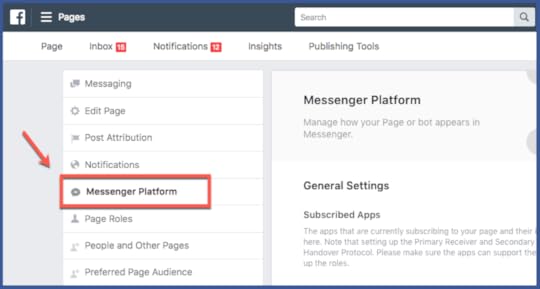

Step 3: Place the following div code in the HTML section of your website to add the plugin.
page_id=””
ref=””
minimized=””>
2 Tips for Using Customer Chat
Before using Customer Chat, keep the following tips from the Messenger Developer blog in mind.
Tip 1: Use Your Customer’s First Name
Begin a welcome message to your customers with their first names. It personalizes the message, making your customers more engaged.
Tip 2: Inform Your Customers They Can Continue a Conversation on Messenger
Include a message at the beginning or end of a conversation that lets customers know they can continue the conversation on the Messenger app outside of your website.
This beta rollout of Customer Chat is only one example of Facebook’s attempts to monetize Messenger. The company is also currently testing a Messenger Broadcast feature, which would allow your business to send mass marketing messages to customers who have previously messaged you.
The post How to Install Facebook Customer Chat to Your Website appeared first on AdvertiseMint.
December 7, 2017
4 Consumer Behaviors Show You Need an E-commerce Store
 December 8, 2017
December 8, 2017Anne Felicitas
If you don't have an #ecommerce store, you could lose a sizeable amount of your customers. #business #retail
Click To Tweet
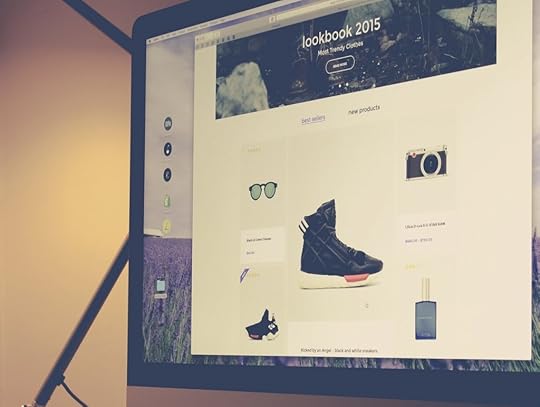
With e-commerce growing 23 percent each year and 51 percent of Americans preferring to shop online, it would be crazy—irresponsible, even—not to own an e-commerce store. Granted, several impediments likely deter you from creating one, such as designing the website and buying a domain. However, the long-term benefits of an e-commerce store outweigh the few inconveniences you have to face to obtain one. In fact, consumer attitudes show that you need an e-commerce store to maintain your business.
1. Consumers Will Prefer Digital Payment Methods
When Forrester and American Express surveyed millennials aged 23 to 37 and Gen Zs aged 16 to 22, they found that these younger generations were more likely to use digital mobile payments such as Paypal, Visa Checkout, and Apple Pay. The reason for this preference, they found, is the need for quick and effortless purchases, a need that could be attributed to the popularity of e-commerce stores where multiple digital payment options are offered.
Because the digital-loving, younger generations are the future’s consumers, it’s likely that they will make digital payments a staple to the shopping experience. If retailers don’t complement their physical stores with online ones where digital payments are offered, they could lose a sizeable amount of their customers.
2. Consumers Prefer Online Shopping
As the success of e-commerce increases, the success of retail decreases. According to Business Insider, 6,300 stores such as Payless, Gymboree, and JCPenny will close by the end of 2017. The reason for this phenomenon that analysts call the retail apocalypse can be attributed to e-commerce’s convenience: people can quickly search for items and check out without leaving the comfort of their homes.
E-commerce is so popular, in fact, that this year many stores closed on Thanksgiving day, a day when shoppers normally stand in line to get ahead on Black Friday shopping. Because Thanksgiving sales declined (on-sale items are available for purchase online on Thanksgiving day), retailers found it economical to close their doors.
3. Consumers Spend Hours Online
Online advertising has made it easier for businesses to reach new customers. Of all the online advertising platforms, social media is the most effective in reaching audiences because it is omnipresent in people’s lives. A study from Qualtrics and Accel found that 42 percent of millennials, 26 percent of Gen Xers, and 29 percent of baby boomers couldn’t last five hours without checking their feeds. People who frequent social media see multiple ads each day, getting more and more acquainted with brands.
Additionally, because social media platforms such as Facebook and Snapchat have online and offline user data and sophisticated ad targeting technology, businesses can reach anyone at anytime, anywhere, whether that’s in a cramped subway, at Starbucks, or at home.
4. The Generation with the Most Purchasing Power Shops Online
According to eMarketer, the generation with the most purchasing power, Gen Xers aged 45 to 54, spend the most time on average per week shopping online. Emarketer also found that of all generations, Gen Xers are more likely to purchase products saved to their carts.
Although Gen Xers spend the most time shopping online, the younger generations aren’t far behind. Unlike Gen Xers who purchase through desktop devices, 64 percent of millennials aged 18 to 24 shop on smartphones.
Starting an e-commerce store may be an inconvenience, but consumer behavior shows that an e-commerce store is integral to maintaining your business.
The post 4 Consumer Behaviors Show You Need an E-commerce Store appeared first on AdvertiseMint.
Facebook Temporarily Blocks Ads Excluding Racial and Ethnic Groups
 December 8, 2017
December 8, 2017Anna Hubbel

Addressing concerns recently raised by lawmakers, Facebook temporarily prohibits advertisers from creating ads that exclude racial and ethnic groups.
Ads excluding racial and ethnic groups temporarily blocked by @Facebook . #nodiscrimination #safefacebook
Click To Tweet
The temporary block will remain in place while Facebook completes an audit of how advertisers exclude minorities such as ethnic, LGBT, and religious groups. Following completion of the audit, Facebook will enforce stricter laws and anti-discrimination policies on advertisers. Before ads can go live, Facebook must first review them, and advertisers must confirm that they understand the law and anti-discrimination policies. These new measures will apply in the coming weeks.
Facebook made the block when the public voiced concerns that the network’s multicultural affinity marketing feature allows advertisers to discriminate against minorities, especially in the areas of housing, credit, and employment. News organization ProPublica recently brought the discrimination concerns to Facebook when it discovered its seamless ability to purchase dozens of rental housing ads on the platform that excluded various minority audiences. The ads allegedly received approval within minutes.
“ProPublica recently found that safeguards we put in place earlier this year were not as comprehensive as they should have been,” Rob Goldman, Facebook’s Vice President of Ads Growth and Solutions, was quoted by USA TODAY. “This was a failure in our enforcement. We must do better.”
Facebook Makes Amends
Facebook’s recent block, which comes not long after the network removed self-reported targeting after advertisers targeted “Jew haters,” is only one among many actions it’s taking to make its advertising platform safe and inclusive. Recently, Facebook vowed to carefully review controversial ads after it discovered that Russia ran politically divisive ads ran during the 2016 US presidential election. The network surrendered the questionable Russian ads to Congress to aid investigators.
The post Facebook Temporarily Blocks Ads Excluding Racial and Ethnic Groups appeared first on AdvertiseMint.
How to Reach Interested Customers During Holiday Peaks
 December 7, 2017
December 7, 2017Anna Hubbel

As mid-December hovers upon us, you’ll want to optimize your ad reach during the peak of the holiday season. Facebook offers various audience targeting options that will help you reach users who will most likely respond to your holiday ads. Here’s what you can do to reach interested customers.
Reach interested customers during the peak of the #holiday season with @Facebook 's #CustomAudience options.…
Click To Tweet
1. Target Customers in Your Engagement Custom Audience
To ensure that you’re reaching consumers most likely to respond to your business, target users in your Engagement Custom Audience. This audience includes anyone who has interacted with your Facebook page, Facebook page content, or Instagram posts. Because these users already expressed interest in your business by engaging with your pages, accounts, and content, they are an audience likely to respond to your holiday ads.
2. Target Customers Who Visited Your Website
The Facebook Pixel is essential to targeting interested customers because it provides the data to create a Website Traffic Custom Audience. The Website Traffic Custom Audience includes customers that interacted with your website in some way, whether that’s purchasing a product, adding items to cart, or visiting a web page.
With the Website Traffic Custom Audience, you can target both existing customers who purchased and customers who came close but didn’t finalize the purchase. For the latter, you can use your remarketing campaign to push customers to buy. To do so, simply select “People who visited specific web pages” when defining your Website Traffic Custom Audience.
3. Target Customers Who Bought from You
One of the most effective ways to obtain information from customers that have bought from you is Lead Ads, which allow for a quick and efficient sign-up process on mobile devices. Lead Ads solicits basic user information such as email addresses and names. This data can then be downloaded in the form of a txt. or csv. file and uploaded to a Custom Audience.
Make this season merry and bright for your business by using all of the targeting and Custom Audience tools available to you.
The post How to Reach Interested Customers During Holiday Peaks appeared first on AdvertiseMint.
December 5, 2017
Messenger Broadcast Will Allow Businesses to Send Mass Marketing Messages
 December 5, 2017
December 5, 2017Anna Hubbel

Facebook may have another marketing tool up its sleeve for its ever growing Messenger app. TechCrunch recently discovered that the company is working on a Messenger Broadcast feature that businesses can use to send mass marketing messages to users. Currently, the feature is only being tested internally.
If @Facebook rolls out #MessengerBroadcast, businesses can send mass marketing messages. #Messenger…
Click To Tweet
According to TechCrunch, the feature allows businesses to create a title, subtitle, and welcome message to distribute to potential or existing customers. Businesses can include a call-to-action button to encourage users to take a desired action, such as visiting the business’ website.
Allegedly, businesses can contact a limited amount of users through a single Messenger Broadcast at no charge. TechCrunch believes it is likely that Facebook would eventually allow businesses to pay to reach more users.
 Messenger Broadcast allows businesses to send mass messages to customers. Photo courtesy of TechCrunch.
Messenger Broadcast allows businesses to send mass messages to customers. Photo courtesy of TechCrunch.If Messenger Broadcast does, in fact, roll out to businesses, businesses can only message users who already started a message thread with them. Before businesses can include users in a Message Broadcast, they need to market to those users in other ways, with Direct-to-Messenger ads, for example, to encourage them to send a message to the business first.
Ads in Messenger
It comes as no surprise that Facebook is looking at Messenger’s marketing potential. Back in January, the company tested carousel ads in the app, although it is unclear as to whether or not the test was successful. Additionally, as theorized in a previous blog post, Messenger’s recent copy of Snapchat’s streak feature is potentially Facebook’s way of creating an environment for Messenger ads to thrive in. Facebook’s test of Messenger Broadcast supports the speculation that the company plans to further the advertising potential of Messenger.
The post Messenger Broadcast Will Allow Businesses to Send Mass Marketing Messages appeared first on AdvertiseMint.



